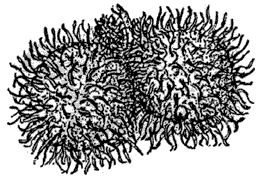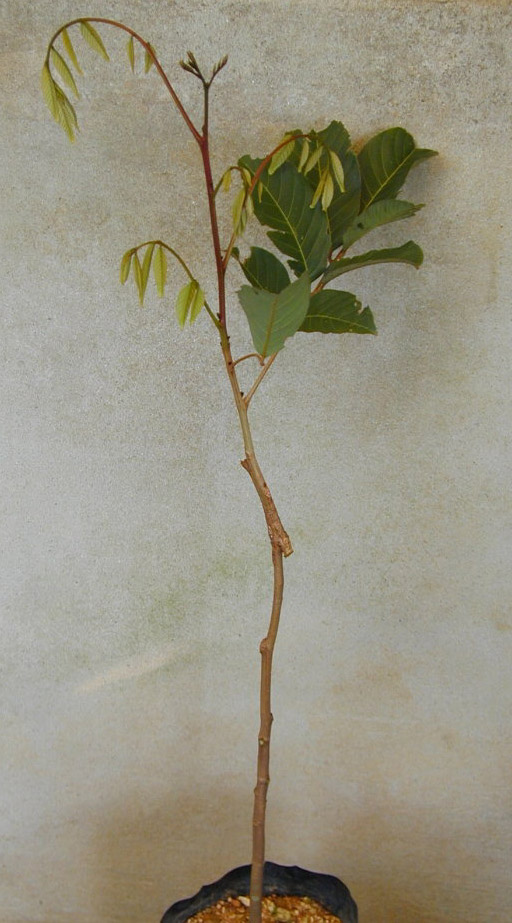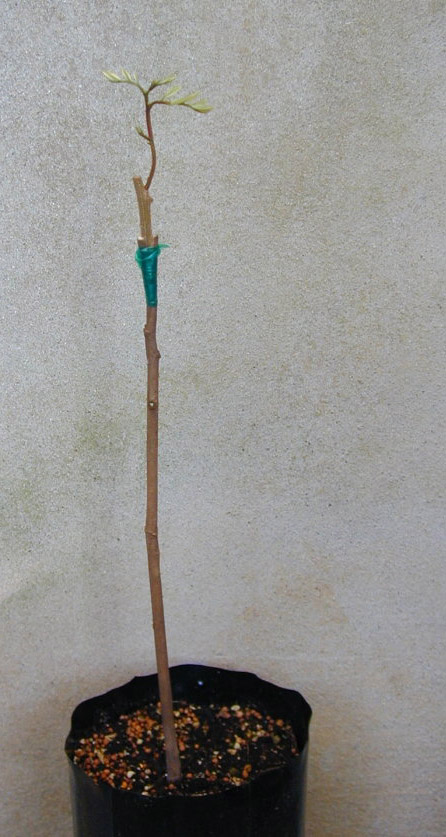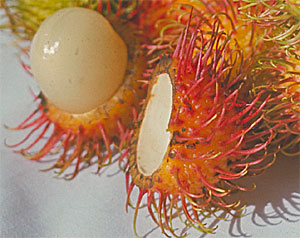

The rambutan (Nephelium lappaceum) is a fruit native to
Malaysia and Indonesia. The name rambutan is derived from the
Malay word for hair, and refers to the external hairlike spinterns on the
fruit. World production is concentrated in Southeast Asia, primarily Thailand,
Indonesia, Malaysia, Singapore and the Philippines (Laksmi et al., 1987),
but production data is not readily available. Rambutan fruits are consumed
fresh as well as canned, and are exported throughout the world either as
fresh fruit, or in frozen or processed form. In recent years, rambutan plantings
have been established in Australia, Hawaii, and in other regions outside
the major areas of production as a specialty tropical fruit crop (Landrigan
et al., 1996; Follett and Sanxter, 2000).
Rambutan in Puerto Rico
Despite the popularity of the quenepa (Melicoccus bijugatus) in
Puerto Rico, other members of the Sapindaceae family, such as lychee, longan,
and rambutan, are virtually unknown. Experience in Puerto Rico with lychee
and longan, although rather limited, has shown these crops to be somewhat
unreliable producers in our tropical environment. Rambutan, being more
adapted to the tropics, may prove more successful.
Although records indicate that individual trees have existed in Puerto
Rico since the 1920's (Britton and Wilson, 1923), recently there has been
increasing interest in rambutan as a new specialty fruit crop for the island.
The first commercial planting of rambutan, a 10 acre orchard in Mayaguez,
was established in 1998. In 1999, experimental rambutan plantings were
established at Experiment Stations in Corozal and Isabela, in a joint effort
between the USDA Tropical Agriculture Research Station and the University
of Puerto Rico Agricultural Experiment Station. As these orchards come into
production, interest in the fruit and demand for planting material should
increase. Currently there is no source of clonal planting material in Puerto
Rico, and grafted or air layered trees must be imported from Hawaii at considerable
expense. Although the Hawaiian trees are of excellent quality, serious
losses of bare root trees have occurred in shipping due to delays and other
problems. Thus, it would be desirable to have a local source of clonally
propagated material for rambutan orchard establishment.
Rambutan Propagation
Rambutan may be propagated by seed, air layers, or grafting. Seeds lose
viability rapidly if allowed to dry out, but may be kept in good condition
for about a month if stored in damp sphagnum moss or sawdust. Disadvantages
of seed propagated trees are delayed bearing, variable fruit quality and
productivity, and unproductive male trees. Thus, seedling trees are used
primarily as rootstocks for grafting, and not for orchard establishment.
Air layering is a common propagation method for the rambutan relatives,
lychee and longan. Although rambutan has been reported to be difficult
to propagate by air layering (Whitehead, 1959; Morton, 1987), air layered
trees of desirable cultivars are commercially available (for example, see
http://www.fruitlovers.com/new.html). One concern with air layered trees
is their lack of an extensive root system and increased susceptibility to
being uprooted by high winds or hurricanes (Galýn Saúco and
Menini, 1984; Crane et al., 1994). I observed this on my own farm in 1998,
after Hurricane Georges passed over Puerto Rico. Seedling lychees remained
standing after experiencing hurricane force winds and over 20 inches (508
mm) of rain, while virtually all of the air layered trees were uprooted.
Various grafting methods for rambutan have been attempted in Puerto Rico
with little success (M. Pérez, 2000, personal communication). Few
references on rambutan grafting are available, and some of the information
is conflicting. Therefore, I wanted to compare several grafting methods
for success under local conditions.
Approach grafting, while more time consuming and complicated than other
methods, has been reported to be very successful for rambutan (Morton,
1987; Sahadevan, 1987). The simpler methods of cleft and side veneer grafting
were described by Morton (1987) as "not too satisfactory".
Various budding techniques have been reported to be successful in rambutan.
According to Whitehead (1959), while shield bud grafts are "not feasible",
modified Forkert budding is very effective. Morton (1987) describes patch
budding with a success rate of 82 to 84%, however this method is somewhat
difficult, as the patch must be cut for a precise fit in the stock. Sahadevan
(1987) and Zee (1993) report bud grafting to be successful in rambutan,
but don't specify the type of bud graft used.
Grafting Experiments
In the present study, I report results of six separate experiments comparing
approach and cleft grafting methods in rambutan. Grafting attempts using
budding were unsuccessful, and are not reported. The rootstocks used in
these experiments were seedling trees grown in plastic bags under 50% shade,
or, in the case of topworked trees in the field, were 5 year old seedling
trees growing in full sun. The rootstock seed source was a freestone type
of rambutan obtained from RÃo Guaycuyacu Farm (http://www.ecuadorexplorer.com/guaycuyacu)
and sown on 28 September 1999. The trees used for rootstocks were about
3 feet (1 meter) tall, with a stem diameter about the thickness of a pencil.
All grafts were wrapped with green plastic grafting tape, which was removed
five to seven weeks later, after success or failure of the graft was evident.
Cleft grafts in the field were wrapped first with grafting tape, then the
entire scion was covered with Parafilm.
The procedures and results of the individual rambutan grafting experiments are summarized in Table 1. In the first experiment, seedling rootstocks growing in bags were moved to the field, and approach grafted with established trees of 'R-167' and 'R-162' rambutan.

This method was highly successful (100%), however, it is cumbersome because
the seedlings must be securely placed around the mother tree, and must be
watered if rainfall is insufficient. Also, the number of grafts that may
be done at a given time is limited by space and available shoots.
The second experiment was with cleft grafting in the shadehouse. In
this experiment, scions were left with three to five leaflets, and the plastic
bags covering the grafts were left slightly open. These two factors probably
contributed to drying and death of the scions, resulting in the low success
rate of 10%.
Experiment 3 also utilized approach grafting, but this time the donor
plants were young grafted trees in bags, and the grafting was done in the
shadehouse. An inverted cleft type graft was used, in which the shoot of
the root stock is severed, and the remaining stub cut to form an inverted
'v'. This 'v' is inserted into a vertical cut in the scion, and the graft
is wrapped with grafting tape. This method is virtually foolproof, as the
scion is allowed to heal before being removed from the donor plant, and
is much easier to do in the shadehouse than in the field. The success rate
in this experiment was 88%.
The fourth experiment attempted to correct some of the errors of Experiment 2. This time, all leaves were removed from the scions, and the plastic bags were completely sealed to prevent desiccation. After 2 weeks, some scions began to get moldy, so at 3 weeks, 1 inch (2.5 cm) breather holes were cut into each bag to reduce humidity. At 5 weeks, the bags were removed.

The changes in technique designed to reduce drying of the scion probably
contributed to the improved success rate of 26%.
Experiment 5 attempted to improve on the success rate of the previous
experiment by providing ventilation earlier (2 weeks after grafting) to
prevent mold growth. Breather holes were also smaller, to avoid desiccation.
However, the success rate did not improve with these modifications, but
remained about the same (23%).
Cleft grafts in the field (topworking established trees) were more successful
than in the shadehouse on seedling rootstocks (42% success rate). This
could be due to the fact that the larger trees contribute to more rapid
and efficient healing of the graft union, or that increased temperatures
under full sun conditions improve the healing process.
Conclusions
Based on the results of these preliminary experiments, the method of
approach grafting is more dependable than cleft grafting for clonal propagation
of desirable varieties in rambutan. Although it is a more cumbersome method
than cleft grafting, the high success rate justifies the extra time and
effort involved, especially when the donor plants are in pots or bags in
a shadehouse instead of large trees in the field. It must be kept in mind
that the sample sizes I worked with are small, and the experiments were done
at different times of the year, which can affect grafting success.
Apparently, moisture loss of the scion, before the graft wound has healed
sufficiently, contributes to graft failure. Covering the graft with a
sealed plastic bag improved the success rate, but mold tended to form on
the scions. Other methods to prevent water loss need to be tried, such
as the use of Parafilm or intermittent mist. The use of Parafilm instead
of plastic bags, and increasing the light levels may improve grafting
success in the shadehouse. In future experiments, I plan to examine the
use of different types of bud and side veneer grafts.
| |
|
|
|
|
|
| |
|
|
|
4 wk-graft scion ringed below graft, stock bent over and partially broken above graft 5 wk-scion cut/removed |
|
| |
|
|
|
2 wk-bag opened but not removed 4 wk-bag removed |
|
| |
|
|
|
4 wk-scion notched halfway through below graft 6 wk-scion notched three quarters through below graft 7 wk-scion cut/removed |
|
| |
|
|
|
3 wk-two 1 inch (2.5 cm) breather holes cut in bag 5 wk-bag removed |
|
| |
|
|
5 'R-9' 6 'R-156' 5 'Binjai' 5 'Rongrien' 5 'R-134' |
2 wk-two breather holes punched through bag with pencil 4 wk-bag removed |
|
| |
|
|
3 'R-9' 2 'Binjai' 4 'Rongrien' |
4 wk-removed Parafilm |
|

References
Britton, N.L. and P.Wilson. 1923. Scientific survey of Porto Rico and
the Virgin Islands. New York Academy of Sciences, New York.
Crane, J., C. Balerdi, R. Campbell, C. Campbell and S. Goldweber. 1994.
Managing fruit orchards to minimize hurricane damage. HortTechnology 4:21-27.
Follett, P.A. and S.S. Sanxter. 2000. Comparison of rambutan quality after
hot forced-air and irradiation quarantine treatments. HortScience 35:1315-1318.
Galýn Saúco, V. and U.G. Menini. 1984. Litchi cultivation.
FAO Plant Production and Protection Paper No. 83, Food and Agriculture
Organization, Rome.
Laksmi, L.D.S., P.F. Lam, D.B. Mendoza Jr., S. Kosiyachinda and P.C. Leong.
1987. Status of the rambutan industry in ASEAN. p. 1-8. In: P.F. Lam and
S. Kosiyachinda (eds.) Rambutan: Fruit development, postharvest physiology
and marketing in ASEAN. ASEAN Food Handling Bureau, Kuala Lumpur, Malaysia.
Landrigan, M., S.C. Morris and K.S. Gibb. 1996. Relative humidity influences
postharvest browning in rambutan (Nephelium lappaceum L.). HortScience
31:417-418.
Morton, J.F. 1987. Fruits of warm climates. J.F. Morton, Miami.
Sahadevan, N. 1987. Greenfingers. Sahadevan Publications, Negeri Sembilan,
Malaysia.
Whitehead, C. 1959. The rambutan, a description of the characteristics
and potential of the more important varieties. Malayan Agric. J. 42:53-75.
Zee, F.T. 1993. Rambutan and pili nuts: Potential crops for Hawaii. p.
461-465. In: J. Janick and J.E. Simon (eds.) New crops. Proceedings of
the 2nd National Symposium New Crops: Exploration, Research and Commercialization.
6-9 October 1991, Indianapolis, Indiana. Wiley, New York.
Site Design and Contents copyright ©: MMI, MMIII, MMXI